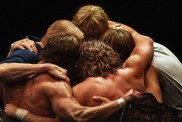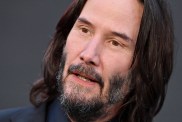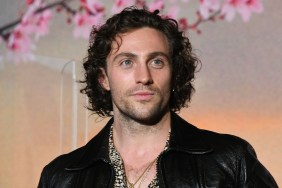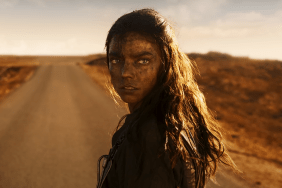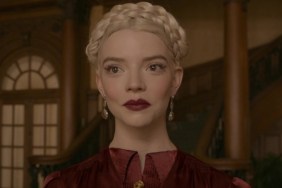
An exclusive interview with The Witch director Robert Eggers and star Anya Taylor-Joy
Former production designer-turned-writer/director Robert Eggers has made the first legitimate horror masterpiece of 2016 in The Witch, his tale of a family — too pious for 17th century Puritan New England — that sets out to live a life in the woods only to succumb to the machinations of a genuine witch. The film features Game of Thrones stars Ralph Ineson and Kate Dickie, but the real star is Anya Taylor-Joy (Vampire Academy) as the oldest daughter whose place in the family becomes uncertain as she comes of age, and later more still as she is accused of witchcraft by her own parents.
The Witch features stunningly accurate period detail, not only in the sets but in the language used by the protagonists. Eggers spent four-years researching the era, and went to great lengths to make the sets as authentic as possible, even going so far as using the same antiquated tools the Puritans used to build them. He also found a spellbinding lead in Taylor-Joy, who projects an authenticity that is palpable.
We got to speak to both Eggers and Taylor-Joy in New York for a wide-ranging exclusive interview where we discussed tackling those Puritan accents, the films and paintings that influenced the film’s signature look, as well as why young people especially will appreciate the film despite its period setting and use of antiquated language.
ComingSoon.net: With the wrong casting this movie becomes a bad dinner theater production of “The Crucible.” How difficult was it to master the “Old New England” accents?
Anya Taylor-Joy: Because of this thing that I do I would just talk to Lucas Dawson, and Lucas has this big, broad Yorkshire accent. The language was never a thing for me. It’s strange but I never even notice it. I’m like, “Oh, this is beautiful, this is poetry, I’m enjoying reading this.” I understand the way it flows, it’s a real way into the world, but the accent was something I was so scared of just because I’d never really heard a broad North Yorkshire accent. Luckily having Lucas there…
CS: He set the tone.
Taylor-Joy: Oh yeah, because he’s a little kid, he can’t control it. It’s really loud, broad.
Robert Eggers: It’s easier to hear his accent than Rob’s.
CS: Well on the same note, how hard was it to find really young people who are uniformly excellent at the Old New England thing?
Robert Eggers: I’m not trying to be a prickbag, but it’s actually the OLD ENGLAND thing. This period was so early that New England doesn’t even have its own culture. By the time of “The Crucible”/Salem Witch Trials then New England begins, in my eyes, to be a little more separate from England culturally. William and Katherine grew up during Queen Elizabeth’s reign, which if you think about it is kinda crazy. It was hard to find. I wanted the kids to be using their own accents, but to be honest only Lucas was using EXACTLY his own. The other two children were slightly modifying their own accents, but it was hard to find kids that were gonna be of a family and realistic, so if they couldn’t speak this language immediately their audition was over. I couldn’t be teaching people how to do this.
CS: “Yo bro, thou art awesome.”
Robert Eggers: Exactly.
Anya Taylor-Joy: (laughs) Drop some sick beats.

CS: Robert, you shot it on the Arri Alexa and it looks gorgeous. There are shots that look like they’re right out of “Barry Lyndon.” However, there are still a few vocal people who say they don’t like seeing period pieces shot on digital because it feels anachronistic. I don’t agree with that, it’s pretty silly reasoning, but what would you say to the film purists about how you captured this era with this level of picture clarity?
Robert Eggers: Sure. I prefer film, I just do. If we’d had more money we would have shot on film. I think to say it’s “anachronistic” to shoot a 17th century film digitally makes no sense because they didn’t have film then either. It’s silly, it’s silly. For what we were doing with the Alexa was great. Obviously the low light levels that it can capture is very helpful on a tight schedule and a tight budget. Also the native aspect ratio 4:3 was really cool because we were shooting 1:66 because we wanted a little more height in the frame.
CS: For the tall trees and the forests.
Robert Eggers: Right. This actually gave us more resolution because we were using more of the sensor, and we were using vintage Cook lenses from the ’40s that were re-housed. Because the aspect ratio was so square we’re actually using more interesting lens characteristics.
CS: Anya, you’re a millennial and I’ve already seen a lot of audiences in your age-range having a little difficulty with the movie, either with the language or the slow-burn pace. What would you say is the best mind-set for a younger audience to come into the film with?
Anya Taylor-Joy: This is very interesting.
Robert Eggers: It’s an interesting question.
Anya Taylor-Joy: That’s a very interesting question! My friends are all, like, Rob’s age… not to say you’re…
Robert Eggers: Old fogies! (laughs)
Anya Taylor-Joy: My favorite thing about this movie is the fact that it is completely and utterly unique and we are not underestimating the audience in the slightest. We are expecting you to be intelligent, to have imagination, and why wouldn’t you want to rise up to that challenge? Come and see it, make up your own mind, and just because something’s not jumping out at you and giving you an instant reaction… sit with the feeling for a little bit and try and picture yourself in that state and immerse yourself in the film. Allow yourself to feel these primal fears that Rob is beautifully reminding us we all have and we’d just forgotten. The witch is a plastic Halloween decoration now, but actually the witch was very frightening thing that had huge repercussions on our history. We should remember that there was that fear.
CS: Especially in the kind of isolation they’re in. There’s no “dial 911,” there’s no sense of security.
Anya Taylor-Joy: Completely. This is the thing, a lot of people my age — I’m 19 — might find it difficult to picture themselves in that place. Take away all the technology we have and shove you in the woods with nobody to hear you scream… that would be pretty scary.
Robert Eggers: It’s funny, I was talking to a friend of mine even older than me, and it was the same thing. He took his brother’s kids camping and they were just absolutely terrified. They didn’t have their iPad and they were terrified of nature, and maybe that can work on some people.

CS: And in terms of the language barrier it’s not that difficult. “Thou” means “you,” etc.
Robert Eggers: Yeah, “thou” and “thee” means “you” and you’re done.
Anya Taylor-Joy: The thing is, I’ve had several friends who have read it with me and they said, “We’re not gonna lie, there are some things I didn’t completely understand but I get the gist.” If you even take yourself out of the mindset of “What are they saying?” and just listen to the inflection and cadence of how we’re speaking it’s pretty simple. There’s a beautiful flow and emotion to the way they speak that you can pick up on without picking up on every single little word.
CS: You could also run this as a silent movie and it would make perfect sense.
Robert Eggers: Yeah. When there were initial fears we were talking through with our sales agent…
Anya Taylor-Joy: Subtitles. (laughs)
Robert Eggers: “Are we gonna need subtitles?” Our agent was just like, “This is bullsh*t. Honestly I don’t understand all the words but the images are so clear you get it.”
CS: As a huge horror guy, when I think about witches I think of “Black Sunday” and “Witchfinder General,” older ones that are set in this era. What were some of your cinematic points of reference?
Robert Eggers: The two witch movies that were cinematic references were “Day of Wrath” and “Haxan.” Our movie, visually, is closest to some things in “Haxan.”
CS: A lot of images in that look like they’re taken from the old woodcuts.
Robert Eggers: Right, same here. That’s the plan. The horror movie that I feel this film reeks of in a way I’m frankly embarrassed about is “The Shining.” That’s a film I was really dissecting in my early 20’s to try to understand how you make a film that has tension throughout the whole thing.
CS: I coincidentally watched that shortly before I saw your movie and the way you use the music and the cutting is very similar. A lot of the horror in “The Witch” comes from the explicitly supernatural elements, but the truly scary stuff is the religious hysteria because that was/is a real phenomena. You obviously researched the sh*t out of this, but how much irony were you approaching the material with?
Robert Eggers: Zero. Just in Shakespearean irony, which has to do with the humor of being a person in the world, but any other kind of irony I don’t care about. That’s why I don’t like a lot of modern horror movies because they’re too meta and they’re all about quoting this and that. For me I was really trying to understand how people in the early modern people actually think witches manifested themselves as a metaphysical truth. I still hope that there’s some ambiguity, some people find zero ambiguity in the film. That wasn’t my intention, but if you see it that way that’s fine. In any case, the real world and the fairy tale world are the same thing in the mind of the early modern person –aside from the extreme intelligentsia- and that’s what I wanted to have onscreen.
CS: There is a legitimate supernatural current running through it, yet so much of what they’re afraid of doesn’t exist.
Anya Taylor-Joy: Yes.
Robert Eggers: Totally, yeah. Any monster only exists in the shadows, the darkness and the unknown. Whether the witch manifests herself physically or all in your imagination she feeds on your fear, she feeds on your despair and you can’t escape her.

CS: That undercurrent also runs through “The Shining,” where there’s a question of how much is happening in Jack’s head vs the reality. What has been the reaction of religious audiences to your film?
Robert Eggers: The ones that I have heard about have been mainly positive. I’m sure there are some people who will be very offended, but I truly was not trying to be judgmental. I love my Puritan family. I couldn’t, myself, be an extreme Calvinist. Predestination is a pretty tough pill for me to swallow personally. Someone in Salt Lake said it was a good film but they couldn’t in good conscience recommend anyone to see it. (laughs)
CS: So you come from a Puritan background?
Robert Eggers: Well I come from New England. (laughs) It’s part of even the secular culture there.
CS: I went to school in Boston.
Robert Eggers: Oh, so you know about it.
CS: There’s a certain priggishness there, even today.
Robert Eggers: Yeah.
CS: Throughout the film I was reminded of Vermeer and other Dutch masters. What were some painters and illustrators of that era that you looked at?
Robert Eggers: I was looking more at English woodcuts for specificity and research in trying to decipher these kind of New Yorker cartoons to understand how it was a button or a beard or a hat. As far as the Dutch golden age stuff we weren’t trying to replicate that, but because we were shooting with natural light it just kinda happens. If you stick someoney in a 17th century outfit next to an open window it’s gonna look like Vermeer. If you stick someone in a dark room with a single source it’s gonna look like Georges de La Tour. It just kinda happens. The one artist who is not of the period but who I quoted was Goya. Even though he’s early romanticism, the black paintings are just witches, that’s just fear, that’s just horror. There’s no time period it’s just visceral.
CS: Especially the one of Saturn eating his child. There’s a lot of that one in the early scenes with the witch and the baby.
Robert Eggers: Yes! Exactly.
The Witch is now playing in theaters. You can read our review of the film by clicking here.
The Witch
-
The Witch

-
The Witch

-
The Witch

-
The Witch

-
The Witch

-
The Witch

-
The Witch

